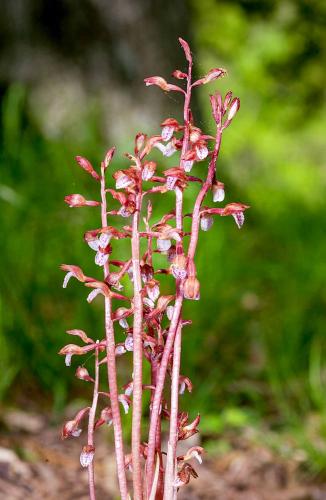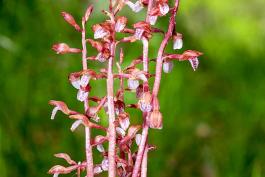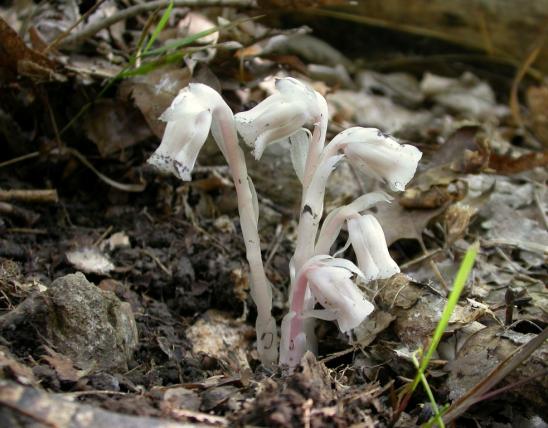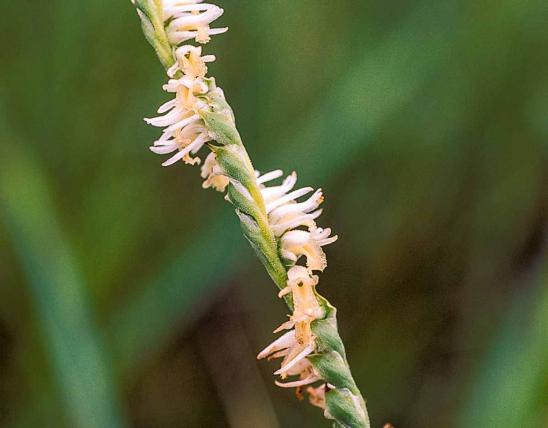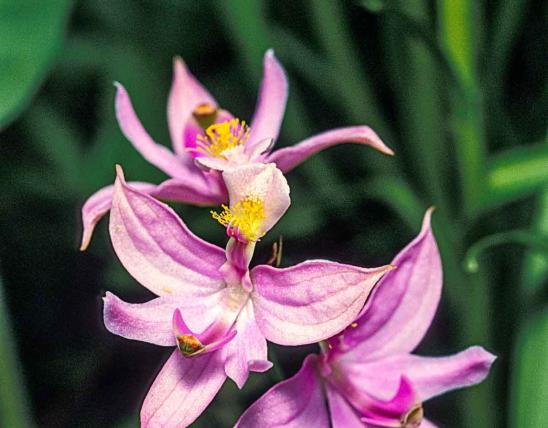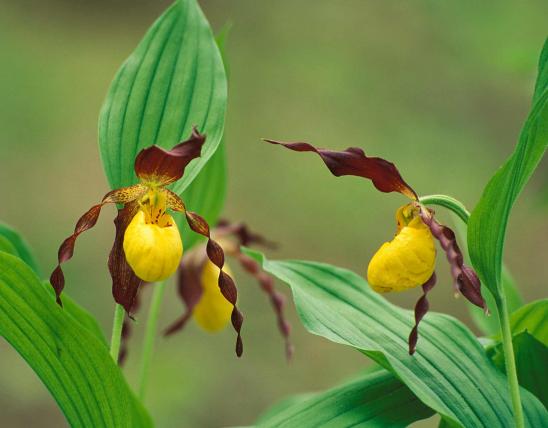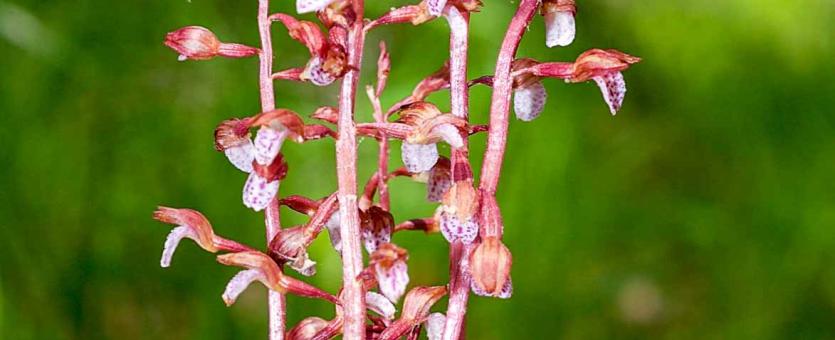
Spring coral root typically blooms in April and May. Except for a few small sheathing bracts along the stem, it has no leaves. The purplish flowers are in a raceme at the tip of the stem. Each flower’s lower lip is white with purple markings.
Spring coral root is a perennial wildflower that blooms in spring from branching underground rhizomes that look something like marine coral. They often appear in a colony. The flowering stems are smooth, yellowish tan to purple, with flowers in a raceme toward the tip. Coral roots have little to no green chlorophyll, and the leaves are reduced to a few small sheathing bracts. Spring coral root has 8–20 flowers per stem. The individual flowers are subtly beautiful and less than about ⅜ inch long; the purplish or brownish (sometimes yellowish-green) sepals and petals join to form a hood over the lower lip, so the lower lip, as it spreads and flares downward, amounts to the only showy, petal-like part of the flower; it is white with magenta-purple markings; the margins are somewhat wavy. In this species, the sepals and lateral (side) petals are 6–8 mm long. Blooms April–May, rarely in September. Fruits are strongly ribbed, ovoid to globe-shaped, hanging capsules.
Spring coral root occasionally has a rare, albino form that lacks purple tinting, so the stems are yellow, the sepals and side petals are yellowish green, and the lips of the flowers are pure white. Specimens of this form of spring coral root have sometimes been confused with another spring-blooming species, called early coral root (Corallorhiza trifida), which does not occur as far south as Missouri.
Similar species: Missouri has one other species of coral root in genus Corallorhiza. It is late coral root (Corallorhiza odontorhiza), which blooms August–November. Its sepals and lateral (side) petals are only 3–4 mm long, and there are 2–20 flowers per stem. Although it can attain a height of 14 inches (equal to spring coral root’s maximum), it may bloom at only 2 inches of height. This species has flowers that, by their very structure, must pollinate themselves. They do not cross-pollinate with other plants. This species is slightly less common than spring coral root (C. wisteriana). Both species are scattered statewide and grow in the same kinds of habitats. Although spring coral root may sometimes bloom in September, bloom time is still the most obvious way to begin separating them.
Somewhat confusingly, Missouri has another, similar orchid that is also called “coral root,” but it is in a different genus: crested coral root (Hexalectris spicata; syn. Bletia spicata). It generally resembles our other coral roots, but crested coral root is taller and has showier flowers. The flowers are about 1 inch wide and have a lower lip that is white with purple veins; it is shallowly 3-lobed, with the central lobe fan-shaped with wavy margins. The remaining petals (2) and sepals (3) are yellow to golden brown and striped with purplish brown; they curve back at their tips.
Height: 4–14 inches.
Scattered statewide in appropriate habitats.
Habitat and Conservation
Occurs in moist upland and bottomland forest and woodlands, frequently on acidic substrates, also sometimes at the edges of glades in rocky soil. Tends to form colonies, with multiple stems arising from the same multiply branched rhizome. Frequently overlooked because its brownish color makes it blend in visually against a background of leaf litter. Typically blooms about the same time as shooting stars and columbines. Once blooming is over, the flowering stalk withers, and there is no sign of the plant’s presence until next spring.
Like other coral roots, spring coral root is an orchid that almost completely lacks chlorophyll, so none of it is green. It obtains nutrients from fungi and decaying organic matter. This aspect of its biology explains why it is found in rich, moist, undisturbed soils, usually amid leaf litter. It also explains why transplanting is almost never successful.
Status
Native perennial wildflower. Mostly lacking chlorophyll, it obtains all nutrients via its relationship with fungi. Not a suitable candidate for transplanting, as specimens usually die when transplanted.
Human Connections
The genus name, Corallorhiza, means “coral root.” The species name, wisteriana, is for Charles J. Wister (1782–1865), who first collected this species in Pennsylvania in 1828.
In some ways, this orchid is easy to overlook, because it blends in against the leaf litter on the forest floor. But when you find one and look closely, you’ll be charmed by the demure beauty of its little flowers. All orchids have obligate relationships with soil-borne, mycorrhizal fungi — but this one more than most — so they do not tolerate environmental changes well. Thus, they do not transplant well into gardens. Please do not dig up orchids from their natural homes. Instead, take photos and videos of your discoveries, or draw and write about them in a journal.
Humans can be judgmental about our fellow earthlings. Many years ago, even botanists used to call coral roots “degenerates” or “beggars” because they have evolved a way of gaining nourishment without chlorophyll. At first, people thought that coral roots tapped into the roots of a host plant, as a parasite; but now we understand they obtain nutrients via their relationship with fungi. Coral roots are not the only plants to have devised such a relationship; and this relationship with fungi can be viewed as an innovation among plants. In recent decades, scientists have avoided using terms implying an “upward” or “downward” evolutionary movement. If an ancient life strategy or physical form still works, and a “living fossil” organism still thrives, there’s no shame. And more recent strategies and forms are not better or worse, admirable or unworthy, as long as they work for the organism. So instead, scientists today use terms like “ancestral” and “derived,” which reflect an organism’s evolutionary history without applying a value on whether it has changed much over time.
Ecosystem Connections
Our coral root orchids almost completely lack chlorophyll, so unlike most other plants, they cannot convert sunlight, water, and carbon dioxide into sugars. Instead, coral roots are mycoheterotrophs: they acquire nutrients via fungi connected to their rhizomes (roots) (the fungi are called mycorrhizal fungi). The fungus, with its network of filaments in the soil, digests materials in the soil, or gains nutrients from its association with the roots of a green plant, and the orchid absorbs nutrients from the fungus. In the case of spring coral root, the associated fungi appear to be two species of russula mushrooms, Russula amoenolens and R. pectinatoides. Remember that the “mushrooms” we see aboveground are merely the fruiting bodies produced by the fungus’s network of hairlike strands underground. Both of these russula species live symbiotically with the roots of certain species of trees. Thus we have a three-way symbiosis: orchid, fungus, and tree!
Apparently, the pollinators for this orchid have not been definitively identified. It has a wide North American range (though it is not common in any region), and it can occur in a variety of forest types, so no doubt a variety of insects can do the job. Small flies, such as mosquitoes and gnats, or small wasps and bees, may be the pollinators. For them, the lower lip of the orchid is both a beacon and a landing pad.
The purplish color of coral root orchids comes from pigments called anthocyanins. These are the same pigments we see in beets, berries, red cabbage, and the purples and reds of fall-color leaves. Just as leaves turn red in fall, when their green chlorophyll deteriorates and the red becomes noticeable, coral roots look purplish in the absence of green chlorophyll.
